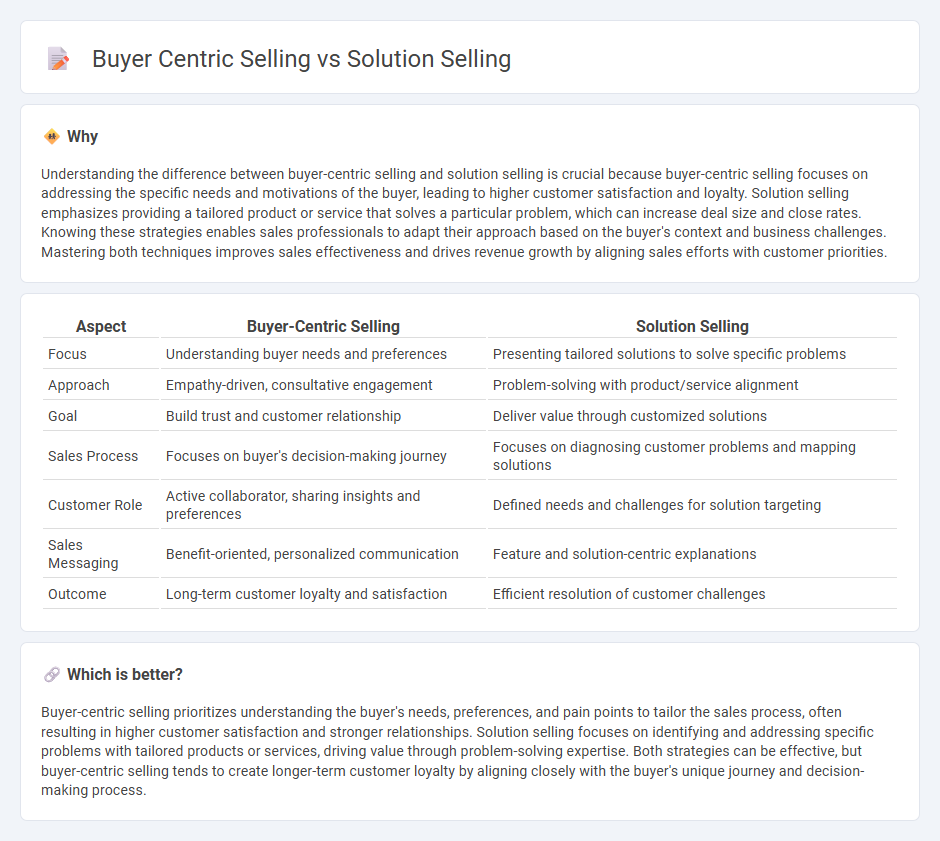
Buyer centric selling focuses on understanding the specific needs, preferences, and pain points of the customer to tailor the sales approach and build long-term relationships. In contrast, solution selling emphasizes identifying a problem and offering a product or service that addresses that issue effectively. Explore the key differences and strategies to master both approaches for enhanced sales outcomes.
Why it is important
Understanding the difference between buyer-centric selling and solution selling is crucial because buyer-centric selling focuses on addressing the specific needs and motivations of the buyer, leading to higher customer satisfaction and loyalty. Solution selling emphasizes providing a tailored product or service that solves a particular problem, which can increase deal size and close rates. Knowing these strategies enables sales professionals to adapt their approach based on the buyer's context and business challenges. Mastering both techniques improves sales effectiveness and drives revenue growth by aligning sales efforts with customer priorities.
Comparison Table
| Aspect | Buyer-Centric Selling | Solution Selling |
|---|---|---|
| Focus | Understanding buyer needs and preferences | Presenting tailored solutions to solve specific problems |
| Approach | Empathy-driven, consultative engagement | Problem-solving with product/service alignment |
| Goal | Build trust and customer relationship | Deliver value through customized solutions |
| Sales Process | Focuses on buyer's decision-making journey | Focuses on diagnosing customer problems and mapping solutions |
| Customer Role | Active collaborator, sharing insights and preferences | Defined needs and challenges for solution targeting |
| Sales Messaging | Benefit-oriented, personalized communication | Feature and solution-centric explanations |
| Outcome | Long-term customer loyalty and satisfaction | Efficient resolution of customer challenges |
Which is better?
Buyer-centric selling prioritizes understanding the buyer's needs, preferences, and pain points to tailor the sales process, often resulting in higher customer satisfaction and stronger relationships. Solution selling focuses on identifying and addressing specific problems with tailored products or services, driving value through problem-solving expertise. Both strategies can be effective, but buyer-centric selling tends to create longer-term customer loyalty by aligning closely with the buyer's unique journey and decision-making process.
Connection
Buyer-centric selling focuses on understanding the buyer's needs, preferences, and pain points to tailor the sales approach effectively. Solution selling aligns closely by offering customized solutions that address specific buyer challenges rather than pushing generic products. Both strategies prioritize creating value for the buyer, enhancing engagement, and driving higher sales conversions.
Key Terms
**Solution Selling:**
Solution Selling emphasizes identifying and addressing specific customer problems with tailored solutions that demonstrate clear value. This methodology relies on a deep understanding of the client's pain points and crafts offerings that directly solve those issues, enhancing customer satisfaction and loyalty. Explore how Solution Selling can transform your sales strategy and drive measurable business growth.
Pain Point Identification
Solution selling emphasizes addressing specific pain points by offering tailored solutions that solve the buyer's challenges, whereas buyer-centric selling prioritizes understanding the buyer's overall experience and needs beyond immediate problems. Effective pain point identification involves deep market research and direct communication to uncover both explicit and implicit customer issues. Explore more insights on enhancing sales strategies through targeted pain point identification.
Customized Solutions
Solution selling emphasizes tailoring products to address specific challenges faced by clients, highlighting the technical benefits and unique features that solve these problems. Buyer centric selling prioritizes understanding the buyer's journey and emotional motivators, ensuring solutions resonate personally and fit individual needs. Explore in-depth strategies of customized solutions to elevate your sales effectiveness.
Source and External Links
Value Selling vs. Solution Selling: Why Value Wins - Solution selling is a sales methodology that focuses on positioning products or services as tailored solutions to specific customer pain points by matching product features to customer needs, aiming to solve immediate challenges.
Solution Selling vs. Consultative Selling: Key Differences - Solution selling is effective for addressing clients' specific challenges by showing how products solve these problems, especially in complex technical or industry-specific scenarios and new product launches.
Solution Selling: What It Is & How to Do It Effectively - Solution selling involves a step-by-step process including prospecting, qualifying, discovering needs, adding value, presenting customized solutions, and closing by aligning offerings with the buyer's specific problems and ROI.
 dowidth.com
dowidth.com